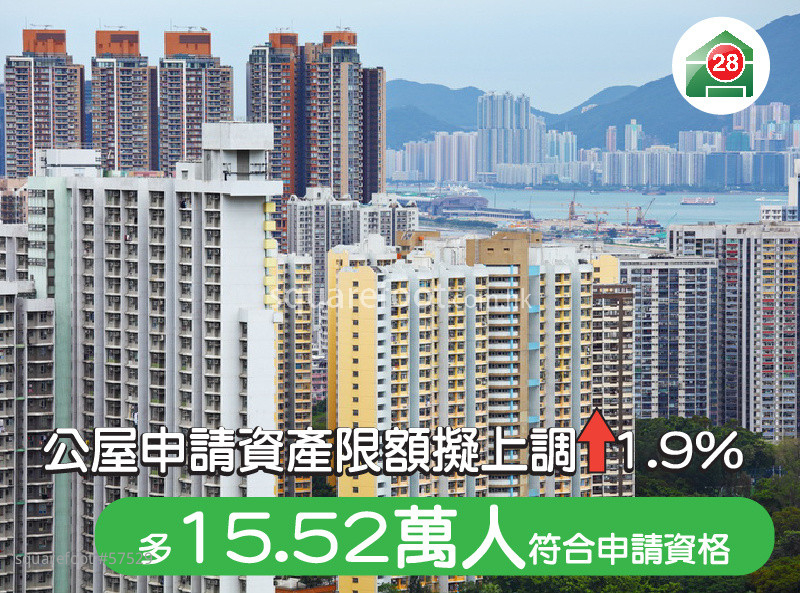- Home
- News
- Expert Blog
- Wed Property Focus
- Asset Limit For Public Housing Applicants To Be Raised By 1.9 Per Cent, Makes 155,200 More People Eligible To Apply
With a high waiting time for public housing, the Housing Authority reviews the income and asset limits of public housing applicants every year to suit the current socioeconomic situation. Taking into account the pandemic’s economic impact, the Housing Authority proposes to freeze the income limits for single- to five-person households, while asset limits are proposed to be adjusted upwards by 1.9 per cent.
Under the existing mechanism, the income limit for public rental housing (PRH) flats is calculated based on household expenditure, which includes both housing and non-housing costs, plus a contingency fund (5 per cent of household expenditure) to ensure that the limits are a realistic reflection of market conditions.
According to the HA's paper, the income limits for single-person to five-person households have all dropped, ranging from 0.9 per cent to 4.2 per cent, among which four-person households fell the most, while single-person fell by 3.7 per cent. Meanwhile, six-person to 10-person households or above have recorded increases ranging from 1.6 per cent to 4.6 per cent.
In view of this, the government proposes to freeze the income limit for single to five-person families, while the income limit for families with six and above will be adjusted according to the established mechanism. Under the new adjustment, the income limit for a single-person household will remain at HK$12,940, while that for a family of six is adjusted from HK$40,840 to HK$42,730.
Regarding the asset limits for PRH flats, the government has made adjustments with reference to the movement of the Consumer Price Index (A) over the past year. Based on the current data, the proposed increase of 1.9 per cent means that the asset limit for a single person will be relaxed to HK$278,000 and for a 3-person household to HK$490,000.
If these proposals are approved, the HA estimates that some 155,200 non-owner-occupied households in the private sector will meet the new income asset limits, representing 30.5 per cent of the total number of households in this category. However, the increase in the number of eligible persons will likely prolong the waiting time for PRH flats.
In addition, as for the "wealthy households in public housing", if the proposal to freeze the income limit for public housing is approved, corresponding adjustments will be made based on the above-mentioned data. If the family income exceeds 2 times but not more than 3 times the public housing income limit, one and a half times the rent must be paid; if the family income exceeds 3 times but not more than 5 times the public housing income limit, double the rent must be paid rent.
For more financially secure tenants, if the proposal to freeze the income limits for PRH flats is approved, corresponding adjustments will be made in accordance with the aforementioned figures. If the household income exceeds the PRH income limits by two but not more than three times, they will be required to pay 1.5 times more rent; if the household income exceeds the PRH income limits by three but not more than five times, they will have to pay double the rent.
The mechanism has been in operation for many years, with frequent calls for a review and revamp. They argue that the rate of adjustment is not linked to the minimum wage, making it easy for grassroots families to exceed the income limit which rendered them ineligible applicants. This defeats the policy intent of helping "low-income households who cannot afford private rental housing".
It is undeniable that in order to adapt to the current environment, it is necessary to modify the relevant mechanism, but only if the problem of the shortage of public housing can be addressed first. Given the current shortage of public housing, there is no excuse for the Government to give priority to helping those in need.
Therefore, the government has no choice but to proceed step by step. In addition to providing "simple public housing", the government needs to speed up the construction of public housing by means of the modular composite construction method to address the most pressing issues, before considering lowering the threshold of application for public housing to help more low-income families.
Like 35
| Property Type | Price | Ads Period |
|---|---|---|
| For Sale Property | ||
Normal Listing Typical One | HKD:1000 (or Hsemoney:1000) | Valid:90 days |
Golden Top Listing Higher position than Top listing 2-3times better performance | HKD:3000 (or Hsemoney:3000) | Valid:60 days |
| Rental Property | ||
Normal Listing Typical One | HKD:1000 (or Hsemoney:1000) | Valid:80 days |
Golden Top Listing Higher position than Top listing 2-3times better performance | HKD:3000 (or Hsemoney:3000) | Valid:60 days |
